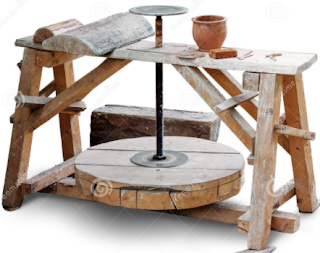Habit is the enormous flywheel of society. ~ William James
Flywheels have
been used for thousands of years. You may not have noticed them because they’re
mostly hidden. Nevertheless, they’ve come a long way despite being unacknowledged
yet essential parts inside millions of everyday machines.
The word “flywheel”
originally appeared in 1784, during the beginnings of the Industrial
Revolution, referring to “a heavy-rimmed revolving wheel to regulate motion.” In
most cases, flywheels transform intermittent reciprocating motion (for example
from a motor’s cylinders) into constant, rotary motion.
The first machine
to use a flywheel was a potter’s wheel. The potter’s wheel arguably has been called
humanity’s most significant machine invention, second only perhaps to the lever.
Some archeologists believe it was invented in Mesopotamia very long ago. Others
have said it was first used in China, South Asia, southeastern Europe and/or
Egypt very long ago. It’s no surprise that its origin isn’t distinct, ancient potters
were making earthenware plates, urns, vases and pots everywhere, even over four
millennia ago.
During the reign
of Egyptian Pharaoh Sneferu, around 2600 BCE, potters lengthened the turntable
shaft and added a separated flywheel directly underneath the wheel. It was a momentous
improvement. The flywheel was moved by the potter pulling the edge with the
left hand while forming the clay on the wheel with the right (potters apparently
were all right-handed way back then). This led to the counterclockwise motion
for the potter's wheel rotation, which after 4,600 years still remains almost
universal. The successful addition of the flywheel not only changed the way
potters made their wares, it significantly increased their quantity and
quality. The lowly flywheel thus has contributed to why archeologists can find
so much primordial earthenware pottery around the globe.
Later, the wheel’s shaft was elongated again, allowing the flywheel to be nearer the floor so the potter could turn it with a foot, as shown below. This allowed her/him to continuously use both hands to shape the item. What a concept, that again improved productivity and value.
Flywheels have fruitfully
spun far beyond potters’ workplaces. They now make mechanical presses, torpedo propellers,
mine locomotives, power hammers, riveting machines and research tokamaks actually
work. Every one of the roughly 1.4 billion (B) fossil-fuel powered vehicles in
the world has a flywheel, along with countless other devices that use reciprocating
engines.
Speaking of which, here’s a picture of the pioneering British rail locomotive developed by Richard Trevithick in 1802. Its gigantic flywheel, about 13ft in diameter, evenly distributed the periodic power of its single-cylinder steam engine.
In a modern incarnation of the flywheel, Jeff Bezos, who is once again the world’s richest person, created a company largely founded on what he termed the “flywheel effect.” Amazon’s flywheel has no physicality or relationship to antique potter’s wheels; it’s a self-supporting growth strategy. Other companies have used similar approaches, none as successfully as Amazon.
From its beginning
the Amazon flywheel meant providing focused investment in making its customer
experience distinctive, worthwhile and valued, so customers would return. In
1994 Bezos founded Amazon as an online seller of books. By 1997, during the
dot-com bubble and its successful IPO, the firm was selling more items,
including music and videos. The Amazon IPO share price was $18, which if you
were then clever enough to buy $100 of them, would now be worth $120,000. Congratulations.
At this point, it’s
hard to think of what Amazon doesn’t sell. When customers repeatedly returned to
amazon.com it drove Amazon to broaden and improve the selection of goods on the
website, which further enhanced its cost structure, due to the benefits of
network effects. This, in turn, allowed Amazon to reduce its prices, further
spinning the flywheel.
Like the giant
flywheel attached to the steam locomotive, it took Bezos and his talented team
a lot of effort at first to get it moving. But once momentum picked up, their
flywheel allowed them to let things unfold with less exertion and more focus on
new opportunities. In 2019, Amazon acquired its 100th company. It currently is
negotiating to buy MGM for $9B. Amazon’s flywheel continues turning ever more rapidly
and has shown itself to be far, far larger than the Trevithick locomotive’s.
Flywheels thus are
worthy of a bit more attention. Going whole flywheel, H.L. Mencken said, “The
universe is a gigantic flywheel and humanity is a fly taking a dizzy ride on it.”
Ride on.



